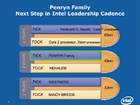Monday, August 6th 2007

Intel Sheds Light on Penryn Enhancements
With Intel's Penryn set to launch next quarter, Intel has decided to shed some light on improvements it has made to the architecture, and prove that Penryn is not just a shrunk Conroe.
Intel has decided to improve existing Wide Dynamic Execution, Advanced Smart Cache, Advanced Digital Media Boost and Intelligent Power Capability, technologies that previously made their debut with Conroe and Merom.
Below is Intel's Tick-Tock long term roadmap, as well as "Penryn" plans (source: HKEPC)Penryn enhances Wide Dynamic Execution technology with a fast radix-16 divider and improved Virtualization technology, which should boost divide instruction capability and reduce virtual machine transition latencies by 25-to-75%.
Advanced Smart Cache not only increases the cache size (6MB and 12MB L2-cache on dual and quad-core CPUs, respectively), but also reduces its latency.
Advanced Digital Media Boost technology is the inclusion of a new Intel SSE4 instruction set. SSE4 introduces 47 new instructions to improve performance of video accelerators, graphics building blocks and streaming load. Intel claims a 2x performance gain in video acceleration tasks. There are 14 new instructions for video accelerator performance enhancement. Intel improves compiler auto-vectorization performance with 32 new instructions.
Intel expects SSE4 optimizations to deliver performance improvements in video authoring, imagine, graphics, video search, off-chip accelerators, gaming and physics applications.
Mobile Penryn processors receive enhanced power saving technologies. New to the mobile Penryn is a deep power down state. In the deep power down state, the processor lowers the core voltage, more so than in the C4 state, and turns off the L1 and L2 caches. Intel claims significant power savings in idle modes for extended battery life with the new power state.
Source:
DailyTech
Intel has decided to improve existing Wide Dynamic Execution, Advanced Smart Cache, Advanced Digital Media Boost and Intelligent Power Capability, technologies that previously made their debut with Conroe and Merom.
Below is Intel's Tick-Tock long term roadmap, as well as "Penryn" plans (source: HKEPC)Penryn enhances Wide Dynamic Execution technology with a fast radix-16 divider and improved Virtualization technology, which should boost divide instruction capability and reduce virtual machine transition latencies by 25-to-75%.
Advanced Smart Cache not only increases the cache size (6MB and 12MB L2-cache on dual and quad-core CPUs, respectively), but also reduces its latency.
Advanced Digital Media Boost technology is the inclusion of a new Intel SSE4 instruction set. SSE4 introduces 47 new instructions to improve performance of video accelerators, graphics building blocks and streaming load. Intel claims a 2x performance gain in video acceleration tasks. There are 14 new instructions for video accelerator performance enhancement. Intel improves compiler auto-vectorization performance with 32 new instructions.
Intel expects SSE4 optimizations to deliver performance improvements in video authoring, imagine, graphics, video search, off-chip accelerators, gaming and physics applications.
Mobile Penryn processors receive enhanced power saving technologies. New to the mobile Penryn is a deep power down state. In the deep power down state, the processor lowers the core voltage, more so than in the C4 state, and turns off the L1 and L2 caches. Intel claims significant power savings in idle modes for extended battery life with the new power state.


53 Comments on Intel Sheds Light on Penryn Enhancements
Just wanted to post a question regarding Intel vs AMD.
I,m not a tech wiz so heres my question's,
All agree?, right now Intel is fastest overall, O.K
but HOW?
Don't Intel's have more on die L2 cache?? (which would increase cost & performance?)
And Don't Intel chips have more transistors on die as well?
And the fact that the chip architecture is convaluted-frankeinstien?
To me there chip arhitecture seem complicated
O.K> but
AMD is a very close contender, right? right.. most won't notice the dif.
To me it seems that AMD is actually doing more with less.. ie a more efficient chip??
The simplicity of there chip architecture and the direct connect approach seems to have greater potential.
I think that AMD is trying to increase Band with so when they do perfect thier true core's potential's and fab process they will not be in the position Intel is with there FSB.
I look at it this way, You don't need to run high mghz if the chip is designed well and that's what we need to under stand.
There are thermal limits to deal with, no?
Intel seems to have the money to jump to easer solutions (more L2/transistore)to "beat" the comp.
So the Comp. has been forced to creat a product with less but that can do the same/more?
Anyway ... just some thought's